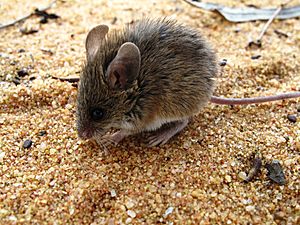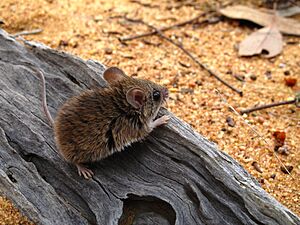Pilliga mouse facts for kids
Quick facts for kids Pilliga mouse |
|
|---|---|
 |
|
| Conservation status | |
| Scientific classification | |
| Genus: |
Pseudomys
|
| Species: |
pilligaensis
|
The Pilliga mouse, also known as the poolkoo, is a small rodent that lives in Australia. Its scientific name is Pseudomys pilligaensis. It mainly lives in the Pilliga forest region of New South Wales. Some have also been found in Warrumbungle National Park and Weetalibah Nature Reserve. Scientists are still studying this mouse, so its conservation status is currently listed as "Data Deficient." This means there isn't enough information yet to know if it's truly endangered.
Contents
What Does the Pilliga Mouse Look Like?
The Pilliga mouse is a small, brown mouse. Its head and back are grey-brown, becoming a bit more reddish-brown on its sides. Its belly is white. Its feet are pale pink on top and covered with white hairs.
From its head to its body, it measures about 73 to 80 millimeters (about 3 inches) long. Its tail is usually about the same length or a little shorter. The tail is pale pink with a clear brown line along the top and a tiny tuft of darker hairs at the very end. Its ears are about 15 to 18 millimeters (about 0.6 to 0.7 inches) long. This little mouse weighs about 10 to 14 grams (less than half an ounce), which is about the weight of two quarters!

How Scientists Study the Pilliga Mouse
The Pilliga mouse was first officially described in 1980 by two scientists, Barry Fox and David Briscoe. They noticed it was different from other similar mice, like the New Holland mouse and the Little native mouse. They looked at things like the size and shape of its skull and how long its tail was compared to its body.
However, some newer studies suggest that the Pilliga mouse might actually be a group of Little native mousees living further south. Another idea is that it could be a mix, or a hybrid, between the Little native mouse and the New Holland mouse. Scientists are still working to figure out exactly where the Pilliga mouse fits in the family tree of rodents.
Where the Pilliga Mouse Lives and Its Home
The Pilliga mouse was first thought to live only in a small part of the Pilliga forest in central New South Wales. But more recent studies show that it lives across the central and eastern parts of the Pilliga forest. After a big bushfire in 2013 that burned much of the Warrumbungle National Park, a Pilliga mouse was even found there!
These mice tend to have more babies and their numbers grow quickly after fires and good rain. They prefer to live in woodlands and heathlands that have lots of shrubs. They especially like areas where plants like Broombush (Melaleuca uncinata) and Bloodwood (Corymbia trachyphloia) grow. The Pilliga mouse is a nocturnal animal, meaning it is active at night. During the day, it sleeps safely in its burrows underground.
Protecting the Pilliga Mouse
As of 2015, the Pilliga mouse is listed as "Data Deficient" by the IUCN. This is because scientists are still unsure if it's a completely separate species. If future research proves it is a unique species, its status would likely change to "Endangered." This means it would be at a very high risk of disappearing forever.
Some of the things that threaten the Pilliga mouse in the Pilliga forest include:
- Energy exploration: Building new roads and equipment for things like coal seam gas can destroy their homes.
- Logging: Cutting down trees for wood can also lead to losing their habitat.
- Predators: Introduced animals like feral cats and red foxes hunt the mice.
- Competition: The common house mouse, which was also introduced, competes with the Pilliga mouse for food and space.
Scientists and conservationists are working to learn more about the Pilliga mouse and protect its habitat to help ensure its future.
See also
 In Spanish: Pseudomys pilligaensis para niños
In Spanish: Pseudomys pilligaensis para niños


